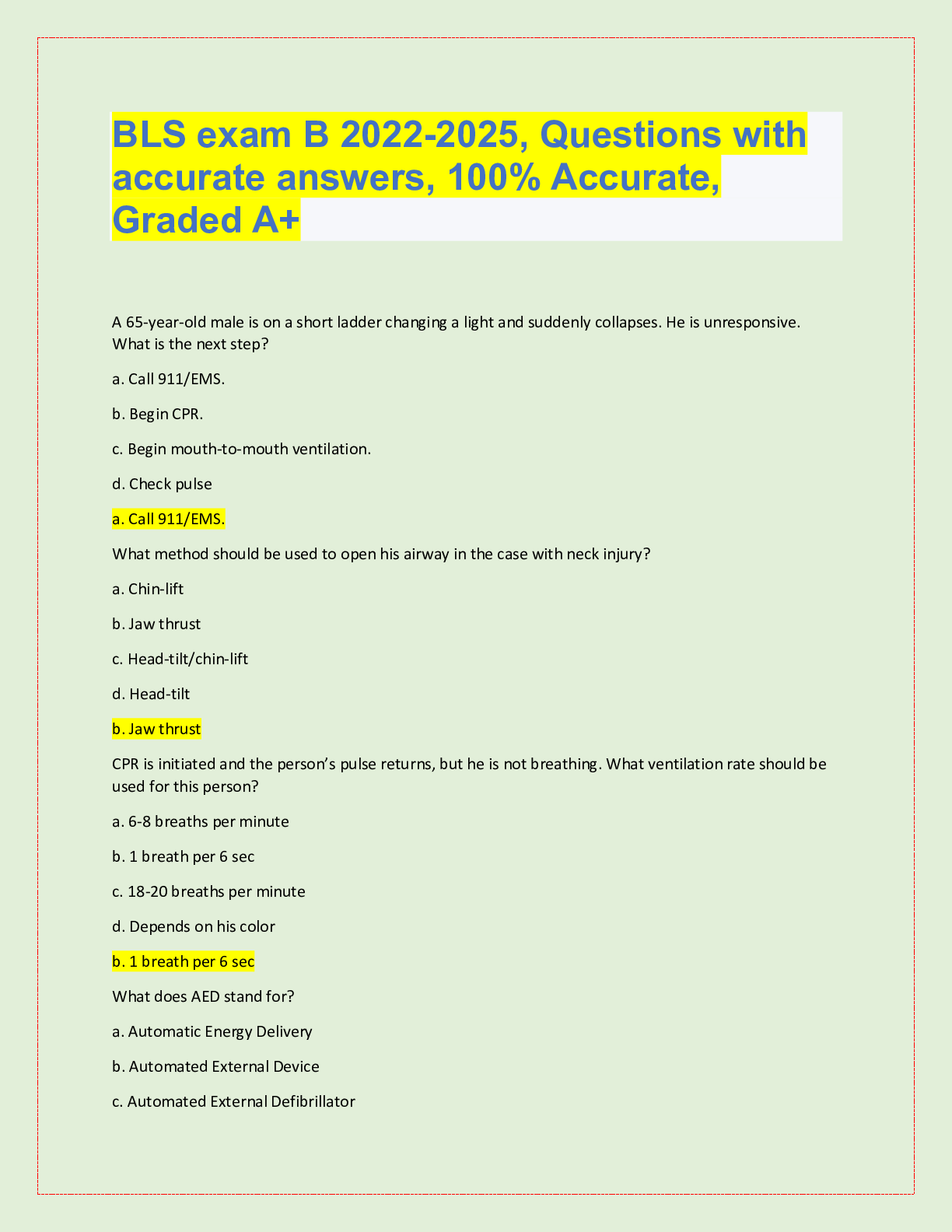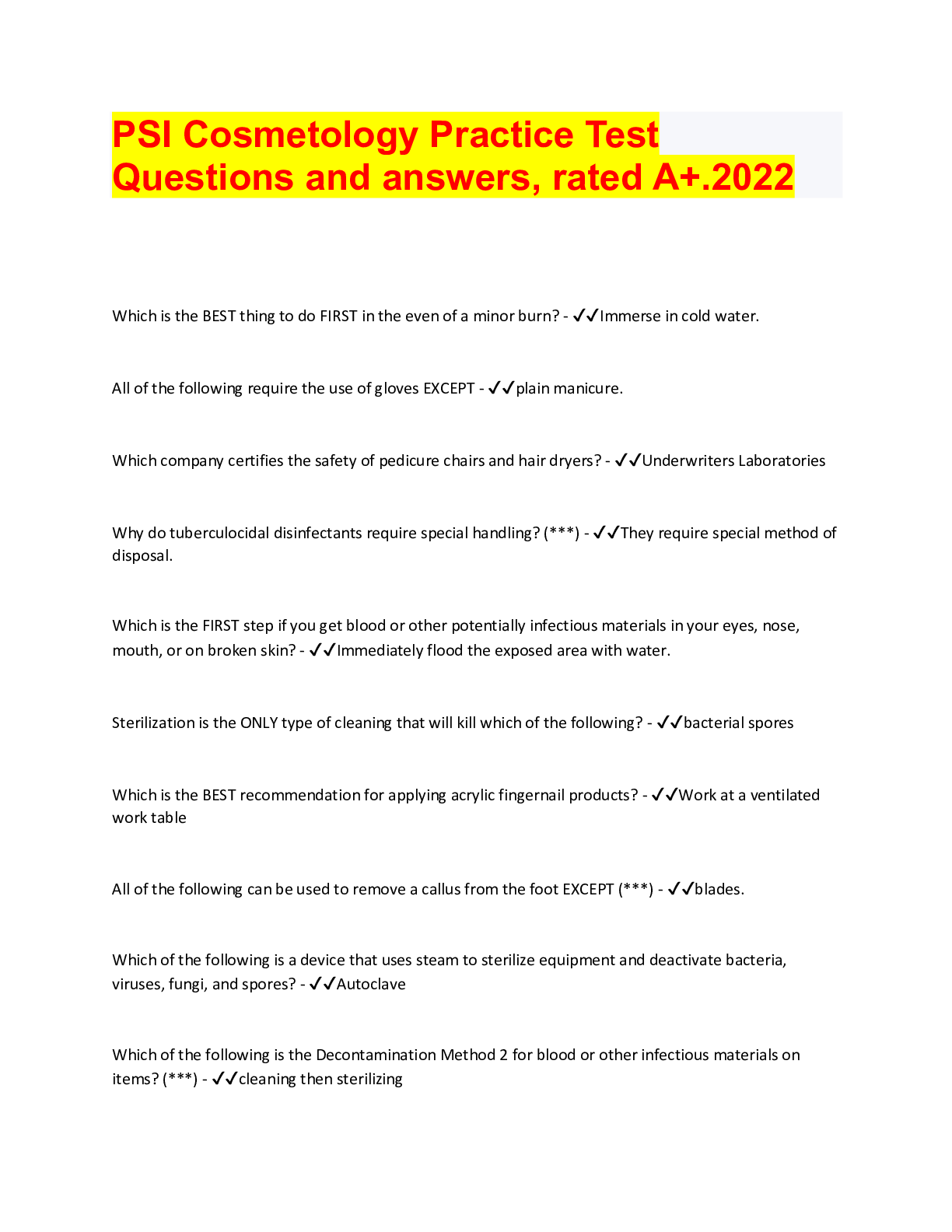Nutrition > QUESTIONS & ANSWERS > NSCA CSCS Chapter 17, Questions and answers, 100% Accurate, rated A+ (All)
NSCA CSCS Chapter 17, Questions and answers, 100% Accurate, rated A+
Document Content and Description Below
NSCA CSCS Chapter 17, Questions and answers, 100% Accurate, rated A+ Resistance training programs for athletes require three aspects in particular, what are they? - ✔✔-1. specificity 2. over... load 3. progression Specificity: - ✔✔-athlete is trained in a specific way for a specific outcome to be produced or adaptation to take place SAID: - ✔✔-stands for "specific adaptations to imposed demands"; choosing movements that will help improve athletic demands ex: squat and vertical jump - the type of demand placed on body will dictate the the type of adaptation that takes place in the body overload: - ✔✔-assigning a workout or training program of greater intensity than athlete is used to; this includes - increasing the load - increasing the number of sessions - adding exercises or sets - complex exercises over simple exercise - decreasing rest periods between sets and exercises progression: - ✔✔-when the intensity of training gets harder gradually - when done properly it provides long term training benefits progression usually includes . . . but can also include. . . - ✔✔-usually includes increasing the amount of weight/ resistance, but can also include raising the number of sessions weekly, adding more drills or increasing training stimulus Resistance training program design includes 7 different variables, what are they? - ✔✔-1. Needs Analysis 2. Exercise selection 3. Training frequency 4. Exercise order 5. Training load and reps 6. Volume 7. Rest periods Needs Analysis: What step is it in the Resistance Training Program Design Variables? - ✔✔-Step one in the resistance training program variables; it is a two step process that includes an (1) an evaluation of the requirements and characteristics of the sport and then (2) an assessment of the athlete (profile) Needs Analysis involves Evaluation of the sport which focuses on . . . - ✔✔-- movement analysis: Body and limb movement patterns and muscular involvement - physiological analysis: strength, power, hypertrophy, and muscular endurance priorities - injury analysis: common sites of joint and muscle injury and what causes it ***also includes cardiovascular endurance, speed & agility, and flexibility Needs Analysis also includes creating an athletic profile which focuses on . . . (4) - ✔✔-the needs and goals of the athlete 1. evaluating their training status 2. conducting variety of test 3. evaluating results 4. determining primary goal of training exercise technique experience: - ✔✔-the knowledge and skill to perform resistance training exercises properly training status: - ✔✔-an athlete's current condition or level of preparedness to begin a new or revised program Exercise Selection: What step is it in the Resistance Training Program Design Variables? - ✔✔-Step 2 of the Resistance Training Program Design; involves choosing exercises for a resistance training program - in order to choose the exercises the S&C individual should understand the nature of various types of resistance training exercises, the movement and muscular requirement of the sport, the athletes exercise technique, experience, training time. core exercises: - ✔✔-involves two or more large muscle areas (chest, shoulder, back, hip, thigh), involves two or more primary joints, and will receive priority due to their direct application to the sport assistance exercises: - ✔✔-usually recruit smaller muscle areas (ab muscles, calf, neck, forearm, lower back), involve only one primary joint and considered less important to improving sports performance all shoulder joints, glenohumeral and shoulder girdle articulations are considered what type of joint in resistance training when categorizing core vs assistance? - ✔✔-considered a primary joint which means it 'd be an assistance exercise - shoulder girdle includes scapular and clavicles assistance exercise usually are for - ✔✔-injury prevention and rehabilitation and focus/ isolate a specific muscle or muscle group assessment of training background should include. . . (4) - ✔✔-1. type of training 2. length of recent training program 3. level of intensity 4. exercise technique experience structural exercise: - ✔✔-a core exercise that either directly loads the back (back squat) or indirectly loads the back (power clean) - structural exercises involve muscular stabilization of posture while performing the lift power exercise: - ✔✔-a structural exercise that is performed very quickly or explosively the more similar the exercise is to the sports movement the more greater likelihood that the movement will transfer over to the sport, this is the concept of ? - ✔✔-SAID specific adaptation to imposed demand muscle balance: - ✔✔-does not always mean equal strength, just a proper ratio of strength, power, or muscular endurance of one muscle or muscle group relative to another muscle or muscle group recovery exercise: - ✔✔-don't involve high muscular stress or hig [Show More]
Last updated: 2 years ago
Preview 1 out of 11 pages

Buy this document to get the full access instantly
Instant Download Access after purchase
Buy NowInstant download
We Accept:

Also available in bundle (1)

NSCA-CSCS Exam Bundle, Top Questions and answers, Approved
NSCA-CSCS Exam Chapter 1 Top Quizzes with accurate answers, 100% Accurate, graded A+, Verified. 28 versions. EXAM MATERIALS.
By Topmark 2 years ago
$40
22
Reviews( 0 )
$9.00
Can't find what you want? Try our AI powered Search
Document information
Connected school, study & course
About the document
Uploaded On
Mar 13, 2023
Number of pages
11
Written in
Additional information
This document has been written for:
Uploaded
Mar 13, 2023
Downloads
0
Views
94


















.png)




